2015年12月ACCA考试P1课程大纲变化
ACCA新大纲变化情况详解(ACCA考试科目F1

ACCA新大纲变化情况详解(ACCA考试科目F1ACCA新大纲变化情况详解(ACCA考试科目F1-F4)2018年04月17日今年,即2018年9月-2019年8月的ACCA考试大纲已经出炉了,就让小编带你来看看9月份F1-F4考试大纲的变化情况吧!每年9月份,ACCA大纲都会进行更新,以求ACCA证书和知识能充分满足所有利益相关者诉求,包括雇主,学生,监管机构、咨询事务所和学习组织。
总体上,ACCA F1-F4考试大纲几乎没有变化。
为什么要说几乎呢?因为F1-F4大纲没变,只有F3的考试内容发生了一些变化。
F3考试更新内容如下:为了匹配国际会计准则15号:收入、折现率的处理作了改变,考官团队为此专门发表一篇文章,来解释这个改变。
国际财务报告准则第15号,与客户签订合约的收益2014年5月,国际会计准则委员会发布了国际财务报告准则第15号“客户合同收入”,取代了“国际会计准则第18号-收入”。
它适用于根据国际财务报告准则报告的所有在2018年1月1日或之后开始的期间的业务。
本文考虑应用国际财务报告准则第15号“客户合同收入”及其对即时付款折扣会计的影响;这与学习F3/FFA的学生最相关。
学习FA1和FA2的学生也将看到即时付款折扣,但国际财务报告准则第15号的基本细节将不太相关。
这一新准则认为在确认收入时采取五步法:第1步:确定与客户的合同第2步:确定合同中的履约义务第3步:确定交易价格第4步:将交易价格分配给合同中的履约义务第5步:在实体满足履约义务时(或作为)确认收入会计折扣向信用客户提供即时支付折扣(也称为结算或现金折扣),以鼓励及时支付其账户。
不能保证客户在销售点可以享受及时的付款折扣,因为它取决于信用卡客户是否在结算窗口内付款。
从历史上看,根据国际会计准则第18号收入,销售点已全额确认提供结算折扣的信贷销售收入。
只有当客户在规定的结算周期内支付(从而接受折扣)时才会对结算折扣进行会计处理。
ACCA考试与科目内容分析P1和P3
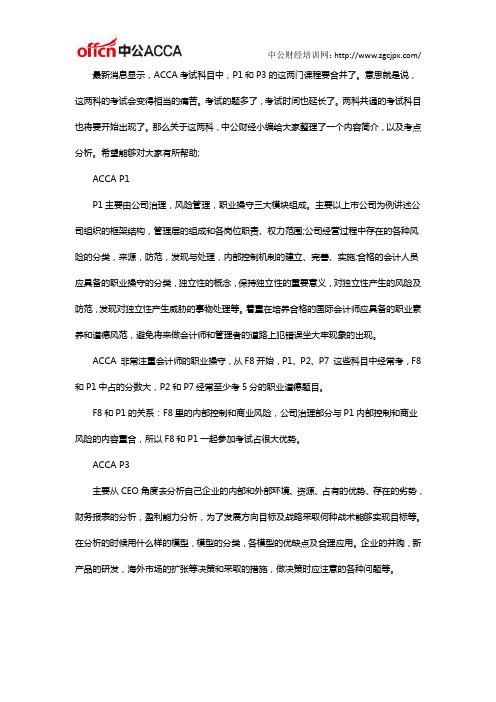
中公财经培训网:/
最新消息显示,ACCA考试科目中,P1和P3的这两门课程要合并了。
意思就是说,这两科的考试会变得相当的痛苦。
考试的题多了,考试时间也延长了。
两科共通的考试科目也将要开始出现了。
那么关于这两科,中公财经小编给大家整理了一个内容简介,以及考点分析。
希望能够对大家有所帮助;
ACCA P1
P1主要由公司治理,风险管理,职业操守三大模块组成。
主要以上市公司为例讲述公司组织的框架结构,管理层的组成和各岗位职责、权力范围;公司经营过程中存在的各种风险的分类,来源,防范,发现与处理,内部控制机制的建立、完善、实施;合格的会计人员应具备的职业操守的分类,独立性的概念,保持独立性的重要意义,对独立性产生的风险及防范,发现对独立性产生威胁的事物处理等。
着重在培养合格的国际会计师应具备的职业素养和道德风范,避免将来做会计师和管理者的道路上犯错误坐大牢现象的出现。
ACCA 非常注重会计师的职业操守,从F8开始,P1、P2、P7 这些科目中经常考,F8和P1中占的分数大,P2和P7经常至少考5分的职业道德题目。
F8和P1的关系:F8里的内部控制和商业风险,公司治理部分与P1内部控制和商业风险的内容重合,所以F8和P1一起参加考试占很大优势。
ACCA P3
主要从CEO角度去分析自己企业的内部和外部环境、资源、占有的优势、存在的劣势,财务报表的分析,盈利能力分析,为了发展方向目标及战略采取何种战术能够实现目标等。
在分析的时候用什么样的模型,模型的分类,各模型的优缺点及合理应用。
企业的并购,新产品的研发,海外市场的扩张等决策和采取的措施,做决策时应注意的各种问题等。
acca各科考试大纲

acca各科考试大纲ACCA各科考试大纲是ACCA考试的重要参考,它详细说明了每门考试科目的内容、考试形式和评分标准。
以下是一些ACCA主要科目的考试大纲概述:1.F1《商业与科技》:本科目涵盖了商业组织、管理、营销、信息技术等方面的知识,旨在测试考生对商业运营和科技应用的理解能力。
2.F2《管理会计》:本科目主要涉及管理会计的基本概念、成本分类、预算编制、差异分析等内容,旨在培养考生的管理会计技能和决策能力。
3.F3《财务会计》:本科目主要考察财务会计的基本原则、财务报表的编制和解读、会计政策的选择等方面,旨在培养考生的财务会计技能和财务报告分析能力。
4.F4《公司法与商法》:本科目主要涉及公司法、合同法、商法等法律领域的基本概念和原则,旨在培养考生的法律意识和商业法律应用能力。
5.F5《业绩管理》:本科目涵盖了业绩评估、成本管理、预算控制等方面的内容,旨在培养考生的业绩管理技能和成本控制能力。
6.F6《税务》:本科目主要涉及税务法规、税务筹划、税务申报等方面的知识,旨在培养考生的税务处理能力和税务筹划能力。
7.F7《财务报告》:本科目是F3的延伸,更深入地探讨了财务报告的编制和分析,包括合并报表、财务分析等内容,旨在培养考生的高级财务报告技能和分析能力。
8.F8《审计与认证业务》:本科目主要涉及审计程序、内部控制评估、风险管理等方面的知识,旨在培养考生的审计技能和风险管理能力。
9.F9《财务管理》:本科目涵盖了投资决策、融资决策、资本结构管理等方面的内容,旨在培养考生的财务管理技能和资本运作能力。
10.P级科目(P1-P7):这些科目是ACCA的高级阶段课程,涵盖了更专业、更深入的领域,如高级业绩管理(P1/P3)、高级财务管理(P2)、高级税务(P6)、高级审计与鉴证(P7)等。
这些科目旨在培养考生在专业领域的高级技能和知识应用能力。
2015年12月ACCA 考试 P2 知识点汇总
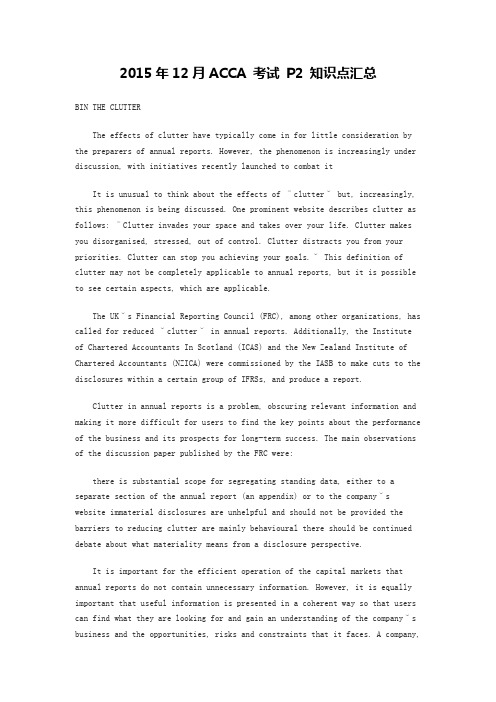
2015年12月ACCA 考试P2 知识点汇总BIN THE CLUTTERThe effects of clutter have typically come in for little consideration by the preparers of annual reports. However, the phenomenon is increasingly under discussion, with initiatives recently launched to combat itIt is unusual to think about the effects of ˉclutterˇ but, increasingly, this phenomenon is being discussed. One prominent website describes clutter as follows: ˉClutter invades your space and takes over your life. Clutter makes you disorganised, stressed, out of control. Clutter distracts you from your priorities. Clutter can stop you achieving your goals.ˇ This definition of clutter may not be completely applicable to annual reports, but it is possible to see certain aspects, which are applicable.The UKˇs Financial Reporting Council (FRC), among other organizations, has called for reduced ˇclutterˇ in annual reports. Additionally, the Institute of Chartered Accountants In Scotland (ICAS) and the New Zealand Institute of Chartered Accountants (NZICA) were commissioned by the IASB to make cuts to the disclosures within a certain group of IFRSs, and produce a report.Clutter in annual reports is a problem, obscuring relevant information and making it more difficult for users to find the key points about the performance of the business and its prospects for long-term success. The main observations of the discussion paper published by the FRC were:there is substantial scope for segregating standing data, either to a separate section of the annual report (an appendix) or to the companyˇs website immaterial disclosures are unhelpful and should not be provided the barriers to reducing clutter are mainly behavioural there should be continued debate about what materiality means from a disclosure perspective.It is important for the efficient operation of the capital markets that annual reports do not contain unnecessary information. However, it is equally important that useful information is presented in a coherent way so that users can find what they are looking for and gain an understanding of the companyˇs business and the opportunities, risks and constraints that it faces. A company, however, must treatall of its shareholders equally in the provision of information. It is for each shareholder to decide whether they wish to make use of that information. It is not for a company to pre-empt a shareholder's rights in this regard by withholding the information.A significant cause of clutter in annual reports is the vast array of requirements imposed by laws, regulations and financial reporting standards. Regulators and standard setters have a key role to play in cutting clutter both by cutting the requirements that they themselves already impose and by guarding against the imposition of unnecessary new disclosures. A listed company may have to comply with listing rules, company law, international financial reporting standards, thecorporate governance codes, and if it has an overseas listing, any local requirements, such as those of the Securities and Exchange Commission (SEC) in the US. Thus, a major source of clutter is the fact that different parties require differing disclosures for the same matter. For example, an international bank in the UK may have to disclose credit risk under IFRS 7, Financial Instruments: Disclosures, the Companies Acts and the Disclosure and Transparency Rules, the SEC rules and Industry Guide 3, as well asthe requirements of Basel II Pillar 3. A problem is that different regulators havedifferent audiences in mind for the requirements they impose on annual reports. Regulators attempt to reach wider ranges of actual or potential users and this can lead to a loss of focus and structure in reports.There may a need for a proportionate approach to the disclosure requirements for small and mid-cap quoted companies that take account of the needs of their investors, as distinct from those of larger companies. This may be achieved by different means. For example, a principles-based approach to disclosures in IFRS, specific derogations from requirements in individual IFRS or the creation of an appropriately adapted local version of the IFRS for SMEs. Pressures of time and cost can understandably lead to defensive reporting by smaller entities and to choosing easy options, such as repeating material from a previous year, cutting and pasting from the reports of other companies and including disclosures of marginal importance.There are behavioural barriers to reducing clutter. It may be that the threat of criticism or litigation could be a considerable limitation on the ability to cut clutter. The threat of future litigation may outweigh any benefits to be obtained from eliminating ˉcatch-allˇ disclosures. Preparers of annual reports are likely to err on the side of caution and include more detailed disclosures than are strictly necessary to avoid challenge from auditors and regulators. Removing disclosures is perceived as creating a risk of adverse comment and regulatory challenge. Disclosure is the safest option and is therefore often the default position. Preparers and auditors may be reluctant to change from the current position unless the risk of regulatory challenge is reduced. Companies have a tendency to repeat disclosures because they were there last year.Explanatory information may not change from year to year but it nonetheless remains necessary to an understanding of aspects of the report. There is merit in a reader of an annual report being able to find all of this information in one place. If the reader of a hard copy report has to switch to look at a website to gain a full understanding of a point in the report, there is a risk that the report thereby becomes less accessible rather than more. Even if the standing information is kept in the same document but relegated to an appendix, that may not be the best place to facilitate a quick understanding of a point. A new reader may be disadvantaged by having to hunt in the small print for what remains key to a full understanding of the report.Preparers wish to present balanced and sufficiently informative disclosures and may be unwilling to separate out relevant information in an arbitrary manner. The suggestion of relegating all information to a website assumes that all users of annual reports have access to the internet, which may not be the case. A single report maybest serve the investor, by having one reference document rather than having the information scattered across a number of delivery points.Shareholders are increasingly unhappy with the substantial increase in the length of reports that has occurred in recent years. This has not resulted in more or better information, but more confusion as to the reason for the disclosure. A review of companiesˇ published accounts will show that large sections such as ˉStatement of Directors Responsibilitiesˇ and ˉAudit Committee reportˇ are almost identical.Materiality should be seen as the driving force of disclosure, as its very definition is based on whether an omission or misstatement could influence the decisions made by users of the financial statements. The assessment of what is material can be highly judgmental and can vary from user to user. A problem that seems to exist is that disclosures are being made because a disclosure checklist suggests it may need to be made, without assessing whether the disclosure is necessary in a companyˇs particular circumstances. However, it is inherent in these checklists that they include all possible disclosures that could be material. Most users of these tools will be aware that the disclosure requirements apply only to material items, but often this is not stated explicitly for users.One of the most important challenges is in the changing audiences. From its origins in reporting to shareholders, preparers now have to consider many other stakeholders including employees, unions, environmentalists, suppliers, customers, etc. The disclosures required to meet the needs of this wider audience have contributed to the increased volume of disclosure. The growth of previous initiatives on going concern, sustainability, risk, the business model and others that have been identified by regulators as ˉkeyˇ has also expanded the annual report size.The length of the annual report is not necessarily the problem but the way in which it is organised. The inclusion of ˉimmaterialˇ disclosures will usually make this problem worse but, in a well organised annual report, users will often be able to bypass much of the information they consider unimportant, especially if the report is on line. It is not the length of the accounting policies disclosure that is itself problematic, but the fact that new or amended policies can be obscured in a long note running over several pages. A further problem is that accounting policy disclosure is often ˉboilerplateˇ, providing little specific detail of how companies apply their general policies to particular transactions.IFRS requires disclosure of ˉsignificant accounting policiesˇ. In other words, IFRS does not require disclosure of insignificant or immaterial accounting policies. Omissions in financial statements are material only if they could, individually or collectively, influence the economic decisions that users make. In many cases, itwould not. Of far greater importance is the disclosure of the judgments made in selecting the accounting policies, especially where a choice is available.A reassessment of the whole model will take time and may necessitate changes to law and other requirements. For example, unnecessary clutter could be removed bynot requiring the disclosure of IFRS in issue but not yet effective. The disclosure seems to involve listing each new standard in existence and each amendment to a standard, including separately all those included in the annual improvements project, regardless of whether there is any impact on the entity. The note becomes a list without any apparent relevance.The IASB has recently issued a request for views regarding its forward agenda in which it acknowledges that stakeholders have said that disclosure requirements are too voluminous and not always focused in the right areas. The drive by the IASB has very much been to increase the use of disclosure to address comparability between companies and, in the short to medium term, a reduction in the volume of accounting disclosures does not look feasible although this is an area to be considered by the IASB for its post 2012 agenda.Written by a member of the Paper P2 examining teamRELEVANT TO ACCA QUALIFICATION PAPER F7 AND P2Studying Paper F7 or P2Performance objectives 10 and 11 are relevant to this examThe IASB抯 Conceptual Framework for Financial ReportingI am from England, and here in the UK, unlike most countries, our system ofgovernment has no comprehensive written constitution. Many countries dohave such constitutions and in these circumstances the laws of the land areshaped and influenced by the constitution. Now while the InternationalAccounting Standards Board (IASB) is not a country it does have a sort ofconstitution, in the form of the Conceptual Framework for Financial Reporting (the Framework), that proves the definitive reference document for the development of accounting standards. The Framework can also be describedas a theoretical base, a statement of principles, a philosophy and a map. By setting out the very basic theory of accounting the Framework points the way for the development of new accounting standards. It should be noted that the Framework is not an accounting standard, and where there is perceived to be a conflict between the Framework and the specific provisions of an accounting standard then the accounting standard prevails.Before we look at the contents of the Framework, let us continue to put the Framework into context. It is true to say that the Framework:seeks to ensure that accounting standards have a consistent approach to problem solving and do not represent a series of ad hoc responses that address accounting problems on a piece meal basisassists the IASB in the development of coherent and consistentaccounting standardsis not a standard, but rather acts as a guide to the preparers of financial statements to enable them to resolve accounting issues that are not addressed directly in a standardis an incredibly important and influential document that helps users understand the purpose of, and limitations of, financial reportingused to be called the Framework for the Preparation and Presentation ofFinancial Statements?is a current issue as it is being revised as a joint project with the IASB's American counterparts the Financial Accounting Standards Board .Overview of the contents of the FrameworkThe starting point of the Framework is to address the fundamental question of why financial statements are actually prepared. The basic answer to that is they are prepared to provide financial information about the reporting entitythat is useful to existing and potential investors, lenders, and other creditors inmaking decisions about providing resources to the entity.In turn this means the Framework has to consider what is meant by useful information. In essence for information to be useful it must be considered both relevant, ie capable of making a difference in the decisions made by users and 2THE IASB CONCEPTUAL FRAMEWORK FOR FINANCIALREPORTINGMARCH 2011be faithful in its presentation, ie be complete, neutral and free from error. Theusefulness of information is enhanced if it is also comparable, verifiable, timely, and understandable.The Framework also considers the nature of the reporting entity and, in whatreminds me of my school chemistry lessons, the basic elements from whichfinancial statements are constructed. The Framework identifies three elementsrelating to the statement of financial position, being assets, liabilities andequity, and two relating to the income statement, being income and expenses.The definitions and recognition criteria of these elements are very importantand these are considered in detail below.The five elementsAn asset is defined as a resource controlled by the entity as a result of pastevents and from which future economic benefits are expected to flow to theentity.Assets are presented on the statement of financial position as beingnoncurrent or current. They can be intangible, ie without physical presence, eggoodwill. Examples of assets include property plant and equipment, financialassets and inventory.While most assets will be both controlled and legally owned by the entity itshould be noted that legal ownership is not a prerequisite for recognition,rather it is control that is the key issue. For example IAS 17, Leases, withregard to a lessee with a finance lease, is consistent with the Framework'sdefinition of an asset. IAS 17 requires that where substantially all the risks andrewards of ownership have passed to the lessee it is regarded as a financelease and the lessee should recognise an asset on the statement of financialposition in respect of the benefits that it controls, even though the assetsubject to the lease is not the legally owned by the lessee. So this reflects thatthe economic reality of a finance lease is a loan to buy an asset, and so the accounting is a faithful presentation.A liability is defined as a present obligation of the entity arising from pastevents, the settlement of which is expected to result in an outflow from the entity of resources embodying economic benefits.Liabilities are also presented on the statement of financial position as being noncurrent or current. Examples of liabilities include trade payables, tax creditors and loans.It should be noted that in order to recognise a liability there does not have tobe an obligation that is due on demand but rather there has to be a present obligation. Thus for example IAS 37, Provisions, Contingent Liabilities and 3THE IASB CONCEPTUAL FRAMEWORK FOR FINANCIALREPORTINGMARCH 2011Contingent Assets is consistent with the Framework's approach whenconsidering whether there is a liability for the future costs to decommission oilrigs. As soon as a company has erected an oil rig that it is required todismantle at the end of the oil rig's life, it will have a present obligation inrespect of the decommissioning costs. This liability will be recognised in full, as a non-current liability and measured at present value to reflect the time value of money. The past event that creates the present obligation is the original erection of the oil rig as once it is erected the company is responsible to incur the costs of decommissioning.Equity is defined as the residual interest in the assets of the entity after deducting all its liabilities.The effect of this definition is to acknowledge the supreme conceptualimportance of indentifying, recognising and measuring assets and liabilities, asequity is conceptually regarded as a function of assets and liabilities, ie a balancing figure.Equity includes the original capital introduced by the owners, ie share capital and share premium, the accumulated retained profits of the entity, ie retained earnings, unrealised asset gains in the form of revaluation reserves and, in group accounts, the equity interest in the subsidiaries not enjoyed by theparent company, ie the non-controlling interest (NCI). Slightly more exotically,equity can also include the equity element of convertible loan stock, equitysettled share based payments, differences arising when there are increases or decreases in the NCI, group foreign exchange differences and contingently issuable shares. These would probably all be included in equity under the umbrella term of Other Components of Equity.Income is defined as the increases in economic benefits during the accounting period in the form of inflows or enhancements of assets or decreases of liabilities that result in increases in equity, other than those relating to contributions from equity participants.Most income is revenue generated from the normal activities of the business in selling goods and services, and as such is recognised in the Income section of the Statement of Comprehensive Income, however certain types of income are required by specific standards to be recognised directly to equity, ie reserves, for example certain revaluation gains on assets. In these circumstances the income (gain) is then also reported in the Other Comprehensive Income section of the Statement of Comprehensive Income.The reference to ther than those relating to contributions from equity participants?means that when the entity issues shares to equity shareholders, 4THE IASB CONCEPTUAL FRAMEWORK FOR FINANCIALREPORTINGMARCH 2011while this clearly increases the asset of cash, it is a transaction with equityparticipants and so does not represent income for the entity.Again note how the definition of income is linked into assets and liabilities. This is often referred to as he balance sheet approach?(the former name for the statement of financial position).Expenses are defined as decreases in economic benefits during the accounting period in the form of outflows or depletions of assets or incurrences of liabilities that result in decreases in equity, other than those relating to distributions to equity participants.The reference to ther than those relating to distributions to equity participants?refers to the payment of dividends to equity shareholders. Such dividends are not an expense and so are not recognised anywhere in the Statement of Comprehensive Income. Rather they represent an appropriationof profit that is as reported as a deduction from Retained Earnings in the Statement of Changes in Equity.Examples of expenses include depreciation, impairment of assets and purchases. As with income most expenses are recognised in the Income Statement section of the Statement of Comprehensive Income, but in certain circumstances expenses (losses) are required by specific standards to be recognised directly in equity and reported in the Other Comprehensive Income Section of the Statement of Comprehensive Income. An example of this is an impairment loss, on a previously revalued asset, that does not exceed thebalance of its Revaluation Reserve.The recognition criteria for elementsThe Framework also lays out the formal recognition criteria that have to be metto enable elements to be recognised in the financial statements. Therecognition criteria that have to be met are thatthat an item that meets the definition of an element andit is probable that any future economic benefit associated with the itemwill flow to or from the entity andthe item cost or value can be measured with reliability.Measurement issues for elementsFinally the issue of whether assets and liabilities should be measured at cost orvalue is considered by the Framework. To use cost should be reliable as thecost is generally known, though cost is not necessary very relevant for theusers as it is past orientated. To use a valuation method is generally regardedas relevant to the users as it up to date, but value does have the drawback ofnot always being reliable. This conflict creates a dilemma that is notsatisfactorily resolved as the Framework is indecisive and acknowledges that5THE IASB CONCEPTUAL FRAMEWORK FOR FINANCIALREPORTINGMARCH 2011there are various measurement methods that can be used. The failure to beprescriptive at this basic level results in many accounting standards sitting onthe fence how they wish to measure assets. For example IAS 40, InvestmentProperties and IAS 16, Property, Plant and Equipment both allow the preparer thechoice to formulate their own accounting policy on measurement.Applying the FrameworkA company is about to enter into a three-year lease to rent a building. Thelease cannot be cancelled and there is no certainty of renewal. The landlordretains responsibility for maintaining the premises in good repair. Thedirectors are aware that in accordance with IAS 17 that technically the lease isclassified as an operating lease, and that accordingly the correct accountingtreatment is to simply expense the income statement with the rentals payable.RequiredExplain how such a lease can be regarded as creating an asset and liability perthe Framework.Solution ?leaseGiven that it is reasonable to assume that the expected life of the premises willvastly exceed three years and that the landlord (lessor) is responsible for themaintenance, on the basis of the information given, the risks and rewards ofownership have not passed. As such IAS 17 prescribes that the lessee chargesthe rentals payable to the income statement. No asset or liability is recognised,although the notes to the financial statements will disclose the existence of thefuture rental payments.However, instead of considering IAS 17 let us consider how the Framework could approach the issue. To recognise a liability per the Framework requires that there is a past event that gives rise to a present obligation. It can beargued that the signing of the lease is a sufficient past event as to create apresent obligation to pay the rentals for the whole period of the lease. On the same basis, while substantially all the risks and rewards of ownership have not passed, the lessee does control the use of the building for three years and has the benefits that brings. Accordingly, when considering the Framework, a radically different potential treatment arises for this lease. On entering thelease a liability is recognised, measured at the present value of the future cashflow obligations to reflect the time value of money. In turn an asset would alsobe accounted for. After the initial recognition of the liability, a finance cost ischarged against profit in respect of unwinding the discount on the liability. Theannual cash rental payments are accounted for as a reduction in the liability.The asset is systematically written off against profit over the three years of theagreement (depreciation).6THE IASB扴 CONCEPTUAL FRAMEWORK FOR FINANCIALREPORTINGMARCH 2011There is, at present, a conflict between IAS 17 and the Framework. The IASB iscurrently reviewing IAS 17 because the current accounting treatment of lessees not recognising the future operating lease rentals as liabilities arguably amounts to off balance sheet financing. The Framework definition of a liability is at the heart of proposals to revise IAS 17 to ensure that the statement of financial position faithfully and completely represents all an entity liabilities. Accordingly this conflict should soon be resolved.Tom Clendon FCCA is a subject expert at Kaplan。
ACCA考试常见问题大集合之P1科目
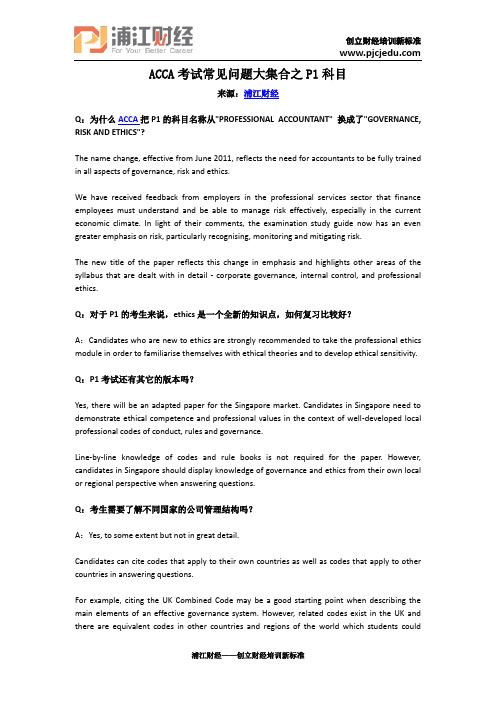
ACCA考试常见问题大集合之P1科目来源:浦江财经Q:为什么ACCA把P1的科目名称从"PROFESSIONAL ACCOUNTANT" 换成了"GOVERNANCE, RISK AND ETHICS"?The name change, effective from June 2011, reflects the need for accountants to be fully trained in all aspects of governance, risk and ethics.We have received feedback from employers in the professional services sector that finance employees must understand and be able to manage risk effectively, especially in the current economic climate. In light of their comments, the examination study guide now has an even greater emphasis on risk, particularly recognising, monitoring and mitigating risk.The new title of the paper reflects this change in emphasis and highlights other areas of the syllabus that are dealt with in detail - corporate governance, internal control, and professional ethics.Q:对于P1的考生来说,ethics是一个全新的知识点,如何复习比较好?A:Candidates who are new to ethics are strongly recommended to take the professional ethics module in order to familiarise themselves with ethical theories and to develop ethical sensitivity.Q:P1考试还有其它的版本吗?Yes, there will be an adapted paper for the Singapore market. Candidates in Singapore need to demonstrate ethical competence and professional values in the context of well-developed local professional codes of conduct, rules and governance.Line-by-line knowledge of codes and rule books is not required for the paper. However, candidates in Singapore should display knowledge of governance and ethics from their own local or regional perspective when answering questions.Q:考生需要了解不同国家的公司管理结构吗?A:Yes, to some extent but not in great detail.Candidates can cite codes that apply to their own countries as well as codes that apply to other countries in answering questions.For example, citing the UK Combined Code may be a good starting point when describing the main elements of an effective governance system. However, related codes exist in the UK and there are equivalent codes in other countries and regions of the world which students couldmention. The study guide specifically mentions the Sarbanes-Oxley Act, as this rules-based legislation has international application.Gaining a broad knowledge and understanding and developing the ability to critically evaluate the key principles of these codes is more important than learning the precise wording or a detailed knowledge of their content and clauses.Q:当考生在支持或者反对某种观点时,需要举例吗?A:Yes, markers will be looking for evidence of understanding and examples can provide them with this.Q:“ETHICAL KNOWLEDGE”和“ETHICAL THEORY”的区别在哪里?A:Candidates are expected to know and to be able to reference "ethical theory". They should then be able to discuss the theory and build a case as to how it may be applied in practice; this is "ethical knowledge."In studying the Professional ethics module, candidates may fully recognise for the first time that issues do not always have clear-cut solutions or answers.Q:P1考生想多拿分挺难,因为考生都没有按照答题思路来答,有什么好的建议吗?A:Marks are awarded for presentation and the logical construction of an answer. It is important for students to become familiar with the formats and approaches (eg annual report, memo, letter) which they may need to utilise in the exam.Candidates should also be aware of the types of answers required when questions use the verbs "assess", "analyse", "evaluate" and "criticise".Q:题干里会出现“critically evaluate”an approach,这是什么意思?This means to evaluate the approach of someone or something, but at the same time to criticise or find fault with it. This form of requirement is intended to test a candidate's ability to produce a cogent and coherent argument, with which they may or may not agree.Q:写答案在答题纸上有什么好的建议吗?It is important to clearly state the question number at the top of the page and indicate the question part near the margin. This will even more important when computerised marking comes in.Q:考生需要在解释要点时举道德难题的例子来得分吗?A:Getting candidates to learn how to apply aspects of the P1 syllabus to real situations is quite a challenge for tuition providers. Many P1 questions require the candidate to deconstruct a situation and examine the issues contained within them. It is therefore very good practice to examine current news stories which cover issues related to the P1 syllabus.There are lots of good materials available in the media and on the internet, particularly at the moment when there are rapidly-changing economic conditions. The challenge for tuition providers is providing relevant, local examples which will capture their candidates' interest and stimulate them to discuss and think about issues covered in P1.Q:很多ACCA考生都不是以英语为母语的,许多国家及地区的考生对于环境审计这样的概念并不是很了解,对此ACCA协会有什么举措吗?A:Examiners and markers are very aware that many candidates are writing in their second or third language. They are very sympathetic to this and are actively looking to award marks.With respect to environmental issues, though, part of the purpose of Paper P1 is to raise awareness of environmental audits. The syllabus covers the tension between issues of corporate governance and commercial pressures.Q:考试会要求考生举行业相关的例子吗?A:Specific examples can be useful to illustrate a certain level of understanding. Questions could be based on examples from specific industries.Q:P1的计算难度如何?考生需要带计算器吗?A:Numbers may be used in an exam question to help enable the analysis of an issue. P1 is not a numerical paper but numerical information can be used as an example.Candidates might need a calculator. There is the option of including numerical content in an answer if it will help to demonstrate understanding of particular point. But there will be no complicated arithmetic.Q:在2010年12月的P1考试中,有道题的题干使用了动词”explore”,这个动词并没有出现在考纲的list of verb上,可以解释一下这个词是什么意思吗?还有其它不在考纲上的动词会出现在卷子上吗?A:The list is not an exhaustive list and the verbs on it are intended to be examples.The word 'explore' gives flexibility to the examiner and the markers since it implies that there are different approaches to answering the question. We are not trying to trip up candidates andany appropriate approach here would be given credit.'Explore' is quite a forgiving word which gives the candidates a certain latitude in approaching the question. Markers are very keen to reward appropriate responses.浦江财经创立财经培训新标准,专业师资团队打造专业财经培训!。
ACCA考试P1——Professional Accountant
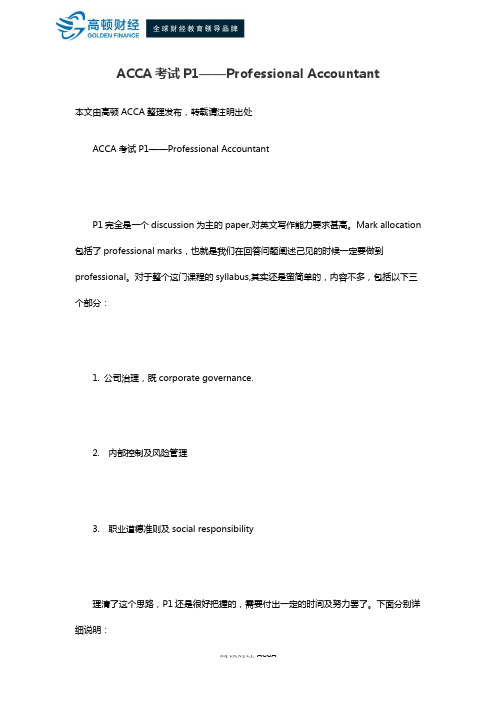
ACCA考试P1——Professional Accountant本文由高顿ACCA整理发布,转载请注明出处ACCA考试P1——Professional AccountantP1完全是一个discussion为主的paper,对英文写作能力要求甚高。
Mark allocation 包括了professional marks,也就是我们在回答问题阐述己见的时候一定要做到professional。
对于整个这门课程的syllabus,其实还是蛮简单的,内容不多,包括以下三个部分:1. 公司治理,既corporate governance.2. 内部控制及风险管理3. 职业道德准则及social responsibility理清了这个思路,P1还是很好把握的,需要付出一定的时间及努力罢了。
下面分别详细说明:1.公司治理这个部分包括的东西比较的杂,需要强化记忆的不多,但是应用是非常重要的,ACCA 的考官喜欢问我们某个公司现在存在什么样的公司治理问题,这个就要求我们能够立刻想到Codes of Corporate Governance中对不同的方面的不同要求,然后在case 中进行应用。
主要需要记忆的部分包括:CG的基本原则各个Sub-committee的不同要求,包括人数、role以及qualification等,包括audit committee, remuneration committee, nomination committee还有risk committee非执行董事的职责、特点以及要求(Higgs Report 2003中说明的4点:Strategy, Scrutiny, Risk, People)Stakeholder Groups(stakeholder matrix),不同的分类,只有我们了解了这些基本的stakeholder,才能做出最符合职业道德的判断Agency theory,这个没有什么难点,就是理解的问题。
acca p1总结 acca p1知识点总结 acca p1经验
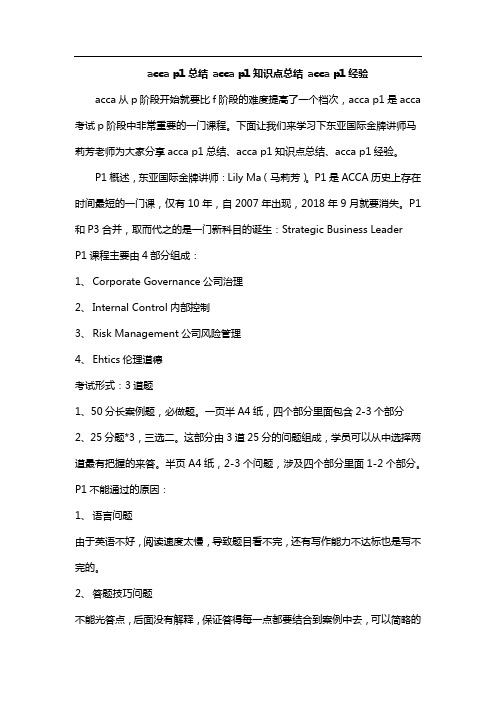
acca p1总结acca p1知识点总结acca p1经验acca从p阶段开始就要比f阶段的难度提高了一个档次,acca p1是acca 考试p阶段中非常重要的一门课程。
下面让我们来学习下东亚国际金牌讲师马莉芳老师为大家分享acca p1总结、acca p1知识点总结、acca p1经验。
P1概述,东亚国际金牌讲师:Lily Ma(马莉芳)。
P1是ACCA历史上存在时间最短的一门课,仅有10年,自2007年出现,2018年9月就要消失。
P1和P3合并,取而代之的是一门新科目的诞生:Strategic Business LeaderP1课程主要由4部分组成:1、Corporate Governance公司治理2、Internal Control内部控制3、Risk Management公司风险管理4、Ehtics伦理道德考试形式:3道题1、50分长案例题,必做题。
一页半A4纸,四个部分里面包含2-3个部分2、25分题*3,三选二。
这部分由3道25分的问题组成,学员可以从中选择两道最有把握的来答。
半页A4纸,2-3个问题,涉及四个部分里面1-2个部分。
P1不能通过的原因:1、语言问题由于英语不好,阅读速度太慢,导致题目看不完,还有写作能力不达标也是写不完的。
2、答题技巧问题不能光答点,后面没有解释,保证答得每一点都要结合到案例中去,可以简略的描述案例中的事实再摆出知识点或者观点。
这也是很多同学过不了的一个主要原因。
3、时间问题时间只有3小时15分钟,答三道题,时间很紧,很多同学会答不完,所以平时就应该掐着时间去练习,控制好时间,做题对于P1是至关重要的。
P1的学习方法:1、知识点的掌握,内容知识点要以理解为主2、活学活用3、在理解基础上背些知识点4、锻炼英文阅读和写作5、多阅读相关参考书6、必须做过去考题做过去考题的步骤:1、带着问题看案例2、自己先思考怎么答,把你的答案点列出来!-不要直接看答案。
解读2015年ACCA P阶段科目大纲
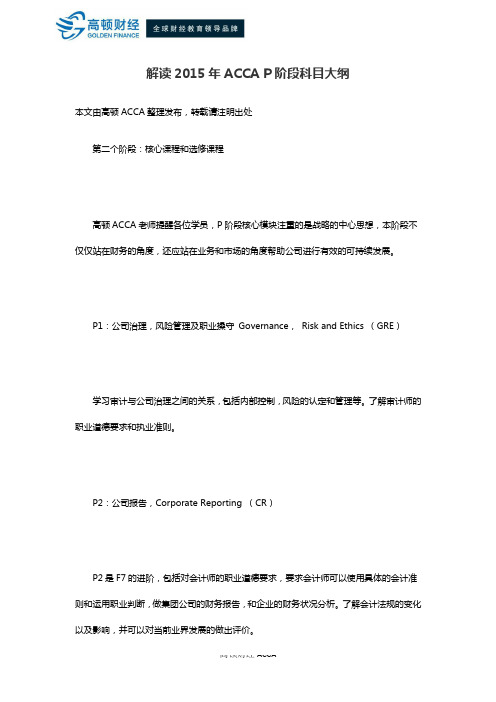
解读2015年ACCA P阶段科目大纲本文由高顿ACCA整理发布,转载请注明出处第二个阶段:核心课程和选修课程高顿ACCA老师提醒各位学员,P阶段核心模块注重的是战略的中心思想,本阶段不仅仅站在财务的角度,还应站在业务和市场的角度帮助公司进行有效的可持续发展。
P1:公司治理,风险管理及职业操守Governance,Risk and Ethics (GRE)学习审计与公司治理之间的关系,包括内部控制,风险的认定和管理等。
了解审计师的职业道德要求和执业准则。
P2:公司报告,Corporate Reporting (CR)P2是F7的进阶,包括对会计师的职业道德要求,要求会计师可以使用具体的会计准则和运用职业判断,做集团公司的财务报告,和企业的财务状况分析。
了解会计法规的变化以及影响,并可以对当前业界发展的做出评价。
P3:商务分析,Business Analysis (BA)高顿P3讲师提示:这门课程70%的内容是MBA第一年的内容,完全把你放在一个CEO和GM的位置上看整个公司的战略管理现状。
学习如何分析企业的战略位置,确定可选方案,做出战略选择,实施战略计划,并结合信息技术,做出相应的人员、程序和结构的调整。
最后对计划的执行情况进行评估。
选修模块为四选二,为一个财务战略阶段的课程,我们不仅关心战略意识,同时让你在战略意识上得到更加深的理解。
P4:高级财务管理,Advanced Financial Management (AFM)学习作为一个高级财务管理人员如何进行财务管理。
具体内容包括企业各相关利益团体之间的矛盾,潜在投资者的投资决策过程,合资和兼并的可能性,企业重组的评估,管理资金风险的技巧,宏观经济因素和国际财务组织对全球性企业的影响,以及财务管理有关的当前发展趋势。
P5:高级业绩管理,Advanced Performance Management (APM)在不同企业环境下管理会计的高级技巧,并将其用于组织的绩效管理。
会计考试之ACCA新大纲主要内容
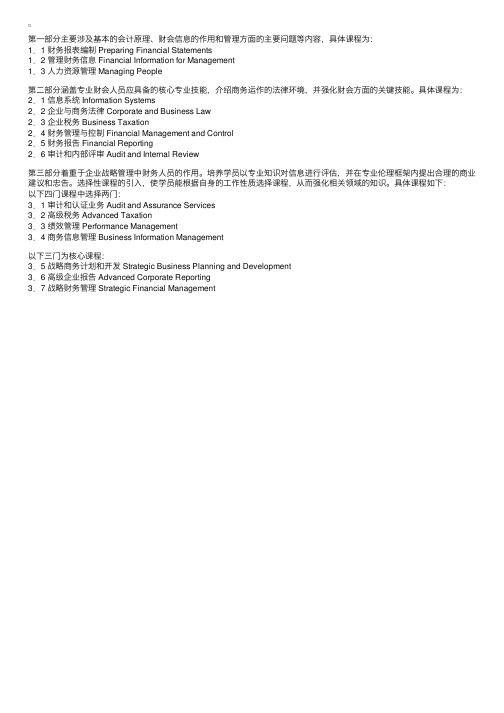
第⼀部分主要涉及基本的会计原理、财会信息的作⽤和管理⽅⾯的主要问题等内容,具体课程为:1.1 财务报表编制 Preparing Financial Statements1.2 管理财务信息 Financial Information for Management1.3 ⼈⼒资源管理 Managing People第⼆部分涵盖专业财会⼈员应具备的核⼼专业技能,介绍商务运作的法律环境,并强化财会⽅⾯的关键技能。
具体课程为:2.1 信息系统 Information Systems2.2 企业与商务法律 Corporate and Business Law2.3 企业税务 Business Taxation2.4 财务管理与控制 Financial Management and Control2.5 财务报告 Financial Reporting2.6 审计和内部评审 Audit and Internal Review第三部分着重于企业战略管理中财务⼈员的作⽤。
培养学员以专业知识对信息进⾏评估,并在专业伦理框架内提出合理的商业建议和忠告。
选择性课程的引⼊,使学员能根据⾃⾝的⼯作性质选择课程,从⽽强化相关领域的知识。
具体课程如下:以下四门课程中选择两门:3.1 审计和认证业务 Audit and Assurance Services3.2 ⾼级税务 Advanced Taxation3.3 绩效管理 Performance Management3.4 商务信息管理 Business Information Management以下三门为核⼼课程:3.5 战略商务计划和开发 Strategic Business Planning and Development3.6 ⾼级企业报告 Advanced Corporate Reporting3.7 战略财务管理 Strategic Financial Management。
2015年12月ACCA考试P1讲义
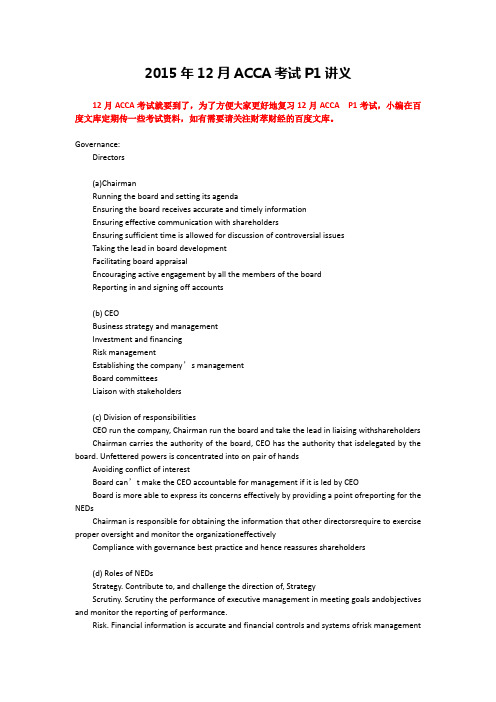
2015年12月ACCA考试P1讲义12月ACCA考试就要到了,为了方便大家更好地复习12月ACCAP1考试,小编在百度文库定期传一些考试资料,如有需要请关注财萃财经的百度文库。
Governance:Directors(a)ChairmanRunning the board and setting its agendaEnsuring the board receives accurate and timely informationEnsuring effective communication with shareholdersEnsuring sufficient time is allowed for discussion of controversial issuesTaking the lead in board developmentFacilitating board appraisalEncouraging active engagement by all the members of the boardReporting in and signing off accounts(b) CEOBusiness strategy and managementInvestment and financingRisk managementEstablishing the company’s managementBoard committeesLiaison with stakeholders(c) Division of responsibilitiesCEO run the company, Chairman run the board and take the lead in liaising withshareholders Chairman carries the authority of the board, CEO has the authority that isdelegated by the board. Unfettered powers is concentrated into on pair of handsAvoiding conflict of interestBoard can’t make the CEO accountable for management if it is led by CEOBoard is more able to express its concerns effectively by providing a point ofreporting for the NEDsChairman is responsible for obtaining the information that other directorsrequire to exercise proper oversight and monitor the organizationeffectivelyCompliance with governance best practice and hence reassures shareholders(d) Roles of NEDsStrategy. Contribute to, and challenge the direction of, StrategyScrutiny. Scrutiny the performance of executive management in meeting goals andobjectives and monitor the reporting of performance.Risk. Financial information is accurate and financial controls and systems ofrisk managementare robust.People. Determining appropriate levels of remuneration for executives, and arekey figures in the appointment and removal of senior managers and in successionplanningContribution of NEDs:Better balanced board(power, skills and experiences)Representing shareholder interests(put shareholders’viewpoint in board discussion,)Monitoring function(monitors risks, controls and operations effectively, theperformance of executive directors)(e) Advantages of NEDsExternal experience and knowledge which executive directors do not possess.Provide a wider perspective than executive directorsA comfort factor for third parties such as investors or creditorsCertain roles (father confessor: being a confidant for the chairmanand other directors; oil-can: intervening to make the board run moreeffectively; high-sheriff: if necessary taking steps to remove thechairman or CEO)Full board members who are excepted to have the level of knowledge that fullboard membership implies.(f) Problems of NEDsLack independence (no business, financial or other connection;Cross-directorships; should not take part in share option schemes and theirservice should not be pensionable; Appointments should not be for aspecified term and reappointment should not be automatic; Procedures shouldexist to ensure NEDs take independent advice)Prejudice and against widening the recruitment of NEDsHigh-calibre NEDs may gravitate towards the best run companiesHave difficulty imposing their views upon the board.Not enough emphasis is given to the role of NEDs in preventing troubleLimited timeDamage company performance by weakening board unity and stiflingentrepreneurship(g) Remuneration packageBasic salary(experience, market rate)Performance related bonuses(transaction bonuses; loyalty bonuses)SharesShare options (align management and shareholder interests, particularlyheld for a long time)Benefits in kind (transport/ health provisions / life assurance /holidays / expenses / loans) Pensions(h) Remuneration policyPay scalesProportion of different types of rewardPeriodBe related to measureable performanceBalance between short and long-term performance elementsTransparencyResponsibilities of the boardFormal schedule of matters specifically reserved to it for decisionat board meetingsMonitoring the CEOOverseeing strategyMonitoring risks, control systems and governanceMonitoring the human capital aspects of the company, eg succession, morale,trainingMonitoring potential conflicts of interestEnsuring that there is effective communication of its strategic plans.Nomination Committee(a)Consist mainly of NEDs, to consider:The balance between executive and independent NEDsThe skills, knowledge and experience possessed by the current boardThe need for continuity and succession planningThe desirable size of the boardThe need to attract board members from a diversity or backgrounds(b)InductionBuild an understanding of the nature of the company, its business and itsmarkets;Build a link with the company’s peopleBuild an understanding of the company’s main relationship including meetingswith auditors(c) Continuing professional developmentExtend their knowledge and skills continuously;Concentrate on the role of board, obligations and entitlements of existing directorsand the behaviors needed for effective board performance.Audit committee(a)FunctionImprove the quality of financial reportingReduce the opportunity for fraudEnable the NEDs continue an independent judgement and play a positive roleHelp the finance director (raise issues of concern; get difficult things done)Strengthen the position of the external auditorThe External auditor can asserthis independence when dispute withmanagementStrengthen the position of the internal auditorIncrease public confidence(b) Review of financial statements andsystemsConsidering performance indicators and information systems that allowmonitoring of the most significant business and financial risks.(c) Liaison with external auditorsBeing responsible for the appointment or removal of the external auditorsAny other threats to external auditor independence (non-audit service; conflictof interest)Discussing the scope of the external auditActing as a forum for liaison between the external auditors, the IAs and thefinance directors Helping the external auditors to obtain the informationMaking themselves available to the external auditors for consultantDealing with any serious reservations.(d)Review of internal auditStandards including objectivity, technical knowledge and professional standardsScope including how much emphasis is given to different types of reviewResources (enough hours, personal technical and skills)Reporting arrangementsWork plan (review of controls and coverage of high risk areas)Liaison with external auditorsResultsRelate to external auditor (increase the independence of external auditor; actas liaison person to facilitate the communication between the executivedirectors and external auditors; Act as coordinate the work between externalauditor and internal auditor;To monitor the independence and quality of workof external auditor)Related to internal audit function (To approve the appointment ortermination???? of appointment of the head of internal audit; To review the workof the internal audit function)(e)Review of internal controlMonitor the adequacy of internal control systems in mitigating???? risks(control environment, management’s attitude)Cover legal compliance and ethicsAddress the risk of fraud (report fraud, frand to be investigated)Reviewing the company’s statement on internal controlsConsider the recommendation of the auditors in the management letter andmanagement’s responseActive supervisory role (review major transactions)(f)Review of risk managementConfirming a formal policy in place for risk management, risk management isupdated to reflect current positions and strategy.(g) Independence of internal auditcommittee:Only be effective if NEDs are independence.Crucial to discuss the management’s competence and judgement with the externalauditors, if not, they may feel loyalty towards managementInvestors’confidenceReporting of the internal audit committee need the NEDs’independence,otherwise influence the integrity of the auditors.Internal auditors/external auditors comparison of role in the context ofcorporate governance(a)Assess the need for internal auditScale, diversity and complexity of the company’s operationsNumber of employeesCost-benefit considerationsChanges in organizational structureChanges in key risksProblems with internal control systemsIncreased number of unexplained or unacceptable events(b)Role of internal audit functionIndependent checking, examination and evaluation the internal control systemestablished by executive director.Internal control over financial reportingFS whether show true and fairInternal control over operationOperational information(management information)Review of “3E”Review of compliance with laws and regulationsReview of safeguarding of the organization’s assetsReview of implementation of corporate goals and objectivesReview of significant risks to the organisation, monitoring risk managementpolicy and risk management strategies.(c) Advantages of appointing internalauditor from outside the company:External appointment would bring detachment and independence (reduce or avoidsthe independence and familiarity threats)An external appointment would help with independence and objectivity. Own nopersonal loyalties nor ‘favours’from previous positions. Have no personalgrievances nor conflicts with other people. (Increase the confidence ofinvestors)Some benefit would be expected from the “new broom effect’in that theappointment would see the company through fresh eyes .(bring a fresh pair ofeyes to the task) Come in with new ideas and expertise gained from other situationsThe possibility exists for the transfer of best practice in from outside.(bestpractice and current developments can be introduced)(d) Review of the risk managementIdentification. Risks comes and go with the changing nature of businessactivity, and with the continual change in any organization’s environment.Assessment. The probability of the risk being realized; the impact or hazard.Review. Analyses the controls that the organization has.Report. A report on the review is produced and submitted to the principal.(e)Social and environmental audit: WhyThere is a growing belief that environment issues represent a source of risk interms of unforeseen liabilities, reputational damage, or similar.The ethical performance of a business, such as its social and environmentalbehaviour, is a factor in some people’s decision to engage with thebusiness in its resource and product markets.An increasing number of investors are using social and environmentalperformance as a key criterion for their investment decisions.(f)Environmental audit: whatIs a systematic, documented, periodic and objective evaluation of how well anentity, itsmanagement and equipment are performing, with the aim of helping tosafeguard the environment by facilitating(??) management control of environmentpractice and assessing compliance with entity policies and externalregulations.。
浅析ACCA新修订纲

浅析ACCA新修订纲浅析ACCA新修订纲浅析ACCA新修订纲acca新修订的考试大纲将从2001年12月开始实施,届时全球在acca注册的所有学员将转入新的考试科目体系,按照新修订的考试大纲参加考试(acca 于2001年6月份举行的考试仍使用原考试大纲)。
acca新修订的考试大纲共分3个阶段16门课程,与原考试大纲(3个阶段6个单元14门课程)相比,新的考试大纲在保留传统考试科目的同时,突出了公司战略、企业系统设计与管理、风险评估和战略财务决策等内容。
第一阶段设置3门考试科目,包括:1.1“编制财务报告(国际)”[preparing financial statements (international)]、1.2“管理财务信息”(financial information for management)、1.3“人力资源管理”(managing people)。
本阶段的目的是要求考生具备形成会计师专业能力所必须的基础专业知识,考试内容主要集中于会计基础知识和基本技能的测试,考试题目中的实务部分仅限于简单的实例。
本阶段主要测试学员以下技能:鉴别并搜集所需要信息的技能、对各种信息的价值进行判断的技能、在简单的实务中将所学的概念和方法得以运用的技能、鉴别基本问题的构成并能够提出解决问题的技能、按一定的逻辑格式分析整理有用信息的技能、清楚简洁地表述和交流信息的技能。
第二阶段设置6门考试科目,包括:2.1“信息系统”(information systems)、2.2“公司及企业法律(英国)”[corporate and business law(uk)]、2.3“企业税务(英国)”[business taxation (uk)]、2.4“财务管理与控制”(financial management and control)、2.5“财务报告(国际)[financial reporting (international)]”、2.6“审计及内部监察(国际)”[audit and internal review (international)].本阶段主要测试学员在实际工作中对所学理论的运用能力、对概念的理解能力。
ACCA考试科目P1跟P3合并了,必考科目变成13门了

中公财经培训网:/ ACCA考试科目P1跟P3合并了,必考科目变成13门了最近,小编突然间发现了一个不得了的秘密。
ACCA最新政策规定,要在9月份ACCA考试科目专业知识部分,P1跟P3要合并一块考试。
那是不是可以这么认为,ACCA必考科目从原先的14科变成了13科呢?其实,关于这两门科目的合并考试,变化的仅仅是科目的多少。
其实,P1与P3的内容并没有完全发生大的变革。
详情如下;P1公司治理和P3商业分析确认合并,成为新的科目“Strategic Business Leader”,考试时间为4小时,对同学们提出了更大的挑战。
而P2高级财务会计,则更名为“Strategic Business Reporting”,也是在2018年9月考试季正式施行。
新政将自2018年9月起正式实施,所以2018月6月将成为P1/P3最后的考试季。
值得注意的是,如果学员2018年9月份之前只通过了P1、P3中的一门,那么,需要参加新科目“StrategicBusiness Leader”的考试,之前的成绩就作废了,所以特别提醒考生:同学们在规划自己P阶段的考试时,要把新政策考虑进去,以避免不必要的时间损失和精力损失。
ACCA一共16个科目,通过14科就可以拿到ACCA准会员证书(最后4科P4-P7是四选二)。
这16个科目的考试顺序也是有规定的。
16科目分为四个大模块:知识模块(F1-F3)、技能模块(F4-F9)、核心模块(P1-P3)、选修模块(P4-P7) 考试必须按照模块顺序来进行,即知识模块-技能模块-核心模块-选修模块。
必须按照这个顺序来报考,但是各个模块内部的科目是可以打乱顺序考的。
例如:F1-F3,可以先考F3,再考F2,再考F1,后面的依此类推。
当然,ACCA每一次考试最多可以报满4科,那么可以把前面模块的都报上,报完以后还有剩余科目可以给后面模块的再报上后面模块的科目。
例如,可以一次把F1、F2、F3、F4都报上,考试结束后,F4、F3、F2都通过了,F1没通过,那么下次报F678等科目时,必须先把F1报上,如果考完了F4-F9的科目,F1还是没通过,报P 阶段时,F1也必须先报上。
acca课程大纲

acca课程大纲第一部分:概述ACCA(Association of Chartered Certified Accountants)是国际上最具影响力的专业会计师协会之一。
ACCA会员具备全球认可的会计和财务管理技能,是世界各地企业所需要的专业人才。
为了培养具备高水平国际会计专业知识和技能的人才,ACCA制定了详细的课程大纲,内容丰富全面,适用于不同层次的学员。
第二部分:课程结构与层次ACCA课程包括三个层次,分别为基础阶段、知识阶段和专业阶段,每个阶段包含若干门课程。
学员可以根据自身背景和目标,选择不同的入学阶段。
基础阶段:此阶段包含三门课程,分别为会计、商法和管理信息系统。
这些课程为学员提供了会计和商业基础知识,为后续深入学习打下扎实的基础。
知识阶段:知识阶段包含六门课程,包括财务会计、管理会计、税务、审计和认证、财务管理以及法律。
这些课程旨在培养学员在各个领域中应用会计知识和技能的能力,为将来的职业发展打下坚实基础。
专业阶段:专业阶段包含四门课程,包括高级财务管理、高级审计与认证、商法与税法以及战略与创新管理。
这些课程旨在让学员深入了解和掌握高级会计领域的知识和技能,为成为会计专业领域的决策者和领导者奠定基础。
第三部分:课程内容与学习方式ACCA课程的大纲内容丰富多样。
每门课程都有特定的授课材料,包括教材和辅助读物。
学员需要通过学习和完成一系列的课程目标和考试,来提高他们的会计技能和知识。
学员可以通过多种学习方式进行ACCA课程的学习,例如参加线下课程、在线学习、独立学习等。
这样的灵活性帮助学员根据自身的学习风格和时间安排进行学习。
第四部分:考试与认证完成ACCA课程后,学员需要参加一系列的在线考试。
这些考试包括多种题型,如选择题、填空题、案例分析等。
学员需要通过这些考试,达到一定的分数才能获得ACCA认证。
ACCA认证是国际上最受认可的会计专业认证之一。
通过获得ACCA认证,学员将获得国际上广泛认可的会计和财务管理技能,增强自身就业竞争力。
ACCA考试经验:P1框架以及考试注意事项
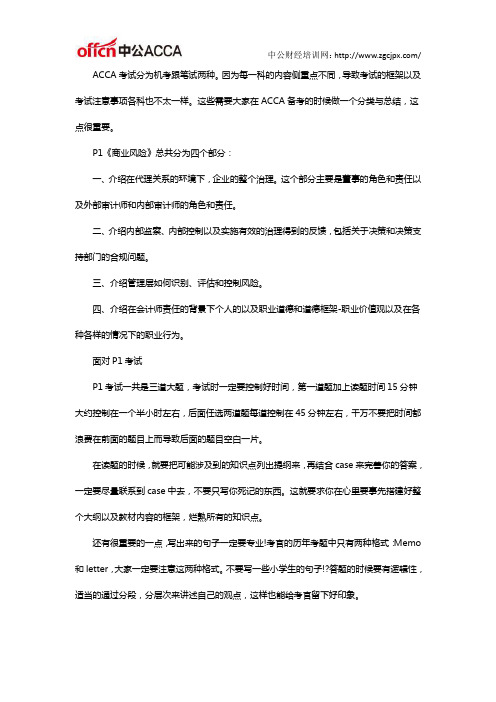
ACCA考试分为机考跟笔试两种。
因为每一科的内容侧重点不同,导致考试的框架以及考试注意事项各科也不太一样。
这些需要大家在ACCA备考的时候做一个分类与总结,这点很重要。
P1《商业风险》总共分为四个部分:
一、介绍在代理关系的环境下,企业的整个治理。
这个部分主要是董事的角色和责任以及外部审计师和内部审计师的角色和责任。
二、介绍内部监察、内部控制以及实施有效的治理得到的反馈,包括关于决策和决策支持部门的合规问题。
三、介绍管理层如何识别、评估和控制风险。
四、介绍在会计师责任的背景下个人的以及职业道德和道德框架-职业价值观以及在各种各样的情况下的职业行为。
面对P1考试
P1考试一共是三道大题,考试时一定要控制好时间,第一道题加上读题时间15分钟大约控制在一个半小时左右,后面任选两道题每道控制在45分钟左右,千万不要把时间都浪费在前面的题目上而导致后面的题目空白一片。
在读题的时候,就要把可能涉及到的知识点列出提纲来,再结合case来完善你的答案,一定要尽量联系到case中去,不要只写你死记的东西。
这就要求你在心里要事先搭建好整个大纲以及教材内容的框架,烂熟所有的知识点。
还有很重要的一点,写出来的句子一定要专业!考官的历年考题中只有两种格式:Memo 和letter,大家一定要注意这两种格式。
不要写一些小学生的句子!?答题的时候要有逻辑性,适当的通过分段,分层次来讲述自己的观点,这样也能给考官留下好印象。
事实上,P1的难度并不高,重要的是要熟悉并吃透知识点,多看多听多想,要开始注重案例的具体分析,不能再“纸上谈兵”了。
ACCA考试经验:P5和P1P3考试经验分享

ACCA考试成绩已经出来了,原科目P1/P2/P3,从通过率来看,不少学员考的都不错,当然也有部分学员考的不是很理想。
考过的学员你可以全身心的备考下一科目,而对于9月需要备考SBL/SBR的学员,建议你多花时间来应对SBR/SBL。
对于P阶段的学员来说,由于P1和P3的合并,以及科目大纲及名称新的变化。
尚未通过P1和P3的学员:2018年9月考季P1和P3将会合并成为新的科目SBL,所以在6月考试成绩公布后,尚未通过P1和P3的学员需要重新学习新的科目SBL再参加考试。
通过P1或P3其中一门的学员:2018年9月考季之后,你的P1或P3成绩将会被取消,需要重新学习并参加SBL考试。
也就是说,如果在9月考季前你只通过了其中一门,那么这门考试的考试费和通过的成绩将会成为一种浪费。
通过P1和P3两门课程的学员:两门课程的通过成绩将会自动转化为SBL的成绩,不需要在学习SBL的课程。
P2科目将会由SBR课程替代,同样如果学习的是P2科目的学员,但是没有及时考试而选择参加9月考试的学员,需要重新学习SBR课程,掌握大纲变动部分,更好的应对考试。
P2 Corporate Reporting 将改名为Strategic Business Reporting,依然是必考科目。
新的科目将会继承P2原有的知识点,经过比较新老科目的考纲后发现,新的科目只是在原来P2的基础上重新做了编排,并没有新增或减少什么值得特别注意的知识。
在考试形式方面,改版后,将不设选做题,所有考题都必须回答。
ACCA建议学员在开始SBR学习之前学习EPSM模块。
该模块的学习需要大约20小时,对战略专业科目大有帮助。
在很多ACCA学员眼里,P5是最难的一科。
即使如此,还是有很多学员很坚定的选择P5.这部分学员通常有个共同点:不擅长计算类型的(P4)也不喜欢税(P6)那么只能选剩下的P7和P5,再是因为本身工作就是做业绩分析的,每个月都在做怎么会惧怕P5。
2015年ACCA P2考试:Hedging详解
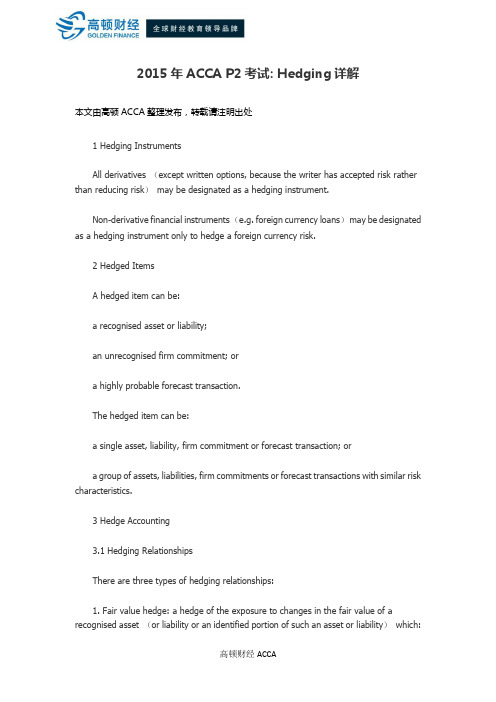
2015年ACCA P2考试: Hedging详解本文由高顿ACCA整理发布,转载请注明出处1 Hedging InstrumentsAll derivatives (except written options, because the writer has accepted risk rather than reducing risk)may be designated as a hedging instrument.Non-derivative financial instruments (e.g. foreign currency loans)may be designated as a hedging instrument only to hedge a foreign currency risk.2 Hedged ItemsA hedged item can be:a recognised asset or liability;an unrecognised firm commitment; ora highly probable forecast transaction.The hedged item can be:a single asset, liability, firm commitment or forecast transaction; ora group of assets, liabilities, firm commitments or forecast transactions with similar risk characteristics.3 Hedge Accounting3.1 Hedging RelationshipsThere are three types of hedging relationships:1. Fair value hedge: a hedge of the exposure to changes in the fair value of a recognised asset (or liability or an identified portion of such an asset or liability)which:is attributable to a particular risk; andwill affect reported profit or loss.2. Cash flow hedge: a hedge of the exposure to variability in cash flows which:is attributable to a particular risk associated with a recognised asset or liability (e.g. all or some future interest payments on variable rate debt)or a highly probable forecast transaction (e.g. an anticipated purchase or sale);andwill affect reported profit or loss.3. Hedge of a net investment in a foreign operation as defined in IAS 21.3.2 Conditions for Hedge AccountingA hedging relationship qualifies for hedge accounting if, and only if, all of the following conditions are met:At the inception of the hedge there is detailed formal documentation of the hedging relationship and the entity's risk management objective and strategy for undertaking the hedge.The hedge is expected to be highly effective (between 80% and 125%)in hedging the risk and this effectiveness can be reliably measured.For cash flow hedges, a forecast transaction (which is the subject of the hedge)must: be highly probable; andpresent an exposure to variations in cash flows which could ultimately affect reported profit or loss.The hedge was assessed on an ongoing basis and determined actually to have been highly effective throughout the financial reporting period.更多ACCA资讯请关注高顿ACCA官网:。
- 1、下载文档前请自行甄别文档内容的完整性,平台不提供额外的编辑、内容补充、找答案等附加服务。
- 2、"仅部分预览"的文档,不可在线预览部分如存在完整性等问题,可反馈申请退款(可完整预览的文档不适用该条件!)。
- 3、如文档侵犯您的权益,请联系客服反馈,我们会尽快为您处理(人工客服工作时间:9:00-18:30)。
2015年12月ACCA考试P1课程大纲变化
ACCA12月的考试就要到了,为了方便大家更好地复习,小编在百度文库定期传一些考试资料,如有需要请关注我的百度文库。
P1考纲有了一些改变,新增了部分的内容,PARTA中,thekeyunderpinningconcepts由原本的九个,新增到了十一个,多了innovation和scepticism,又新增了一整块的内容,Publicsectorgovernance,考官有一篇专门的文章关于这一部分,建议考生仔细的研读。
另一个比较重大的改变在PARTE部分,在E2D的部分,新加了strategicCSR,而E7的部分,加了很大的篇幅,环境报告,环境会计,与环境审计均做了重点的强调。
其实环境与社会责任审计,在2014年6月的考试里,已经直接出现在第三题中。
在未来的考试里,也很有可能作为一个大题出现。
总体来说,新的考纲增加了过去比较少考的一些部分,总体的难度相较过去为高。
2015年ACCA考试P1考试形式:
P1的考试时长为3小时,分为两个部分,A部分一道题50分为必选题,是案例分析的模式;B部分共有三道题每道25分,可以任选两题作答。
2014年12月的考题题型没有任何变化。
ACCA第二阶段核心课程和选修课程
P1:公司治理,风险管理及职业操守Governance, Risk and Ethics (GRE)
学习审计与公司治理之间的关系,包括内部控制,风险的认定和管理等。
了解审计师的职业道德要求和执业准则。
